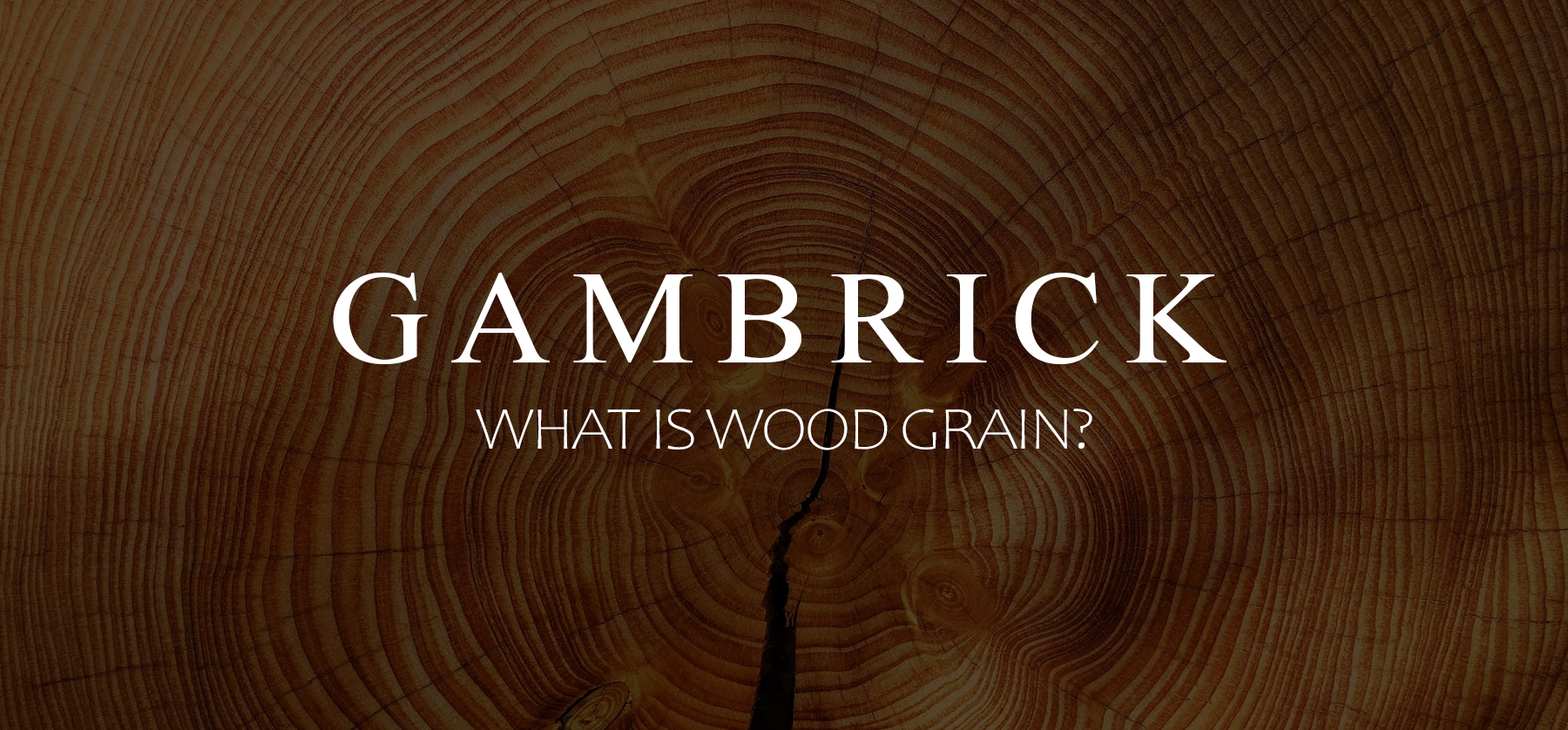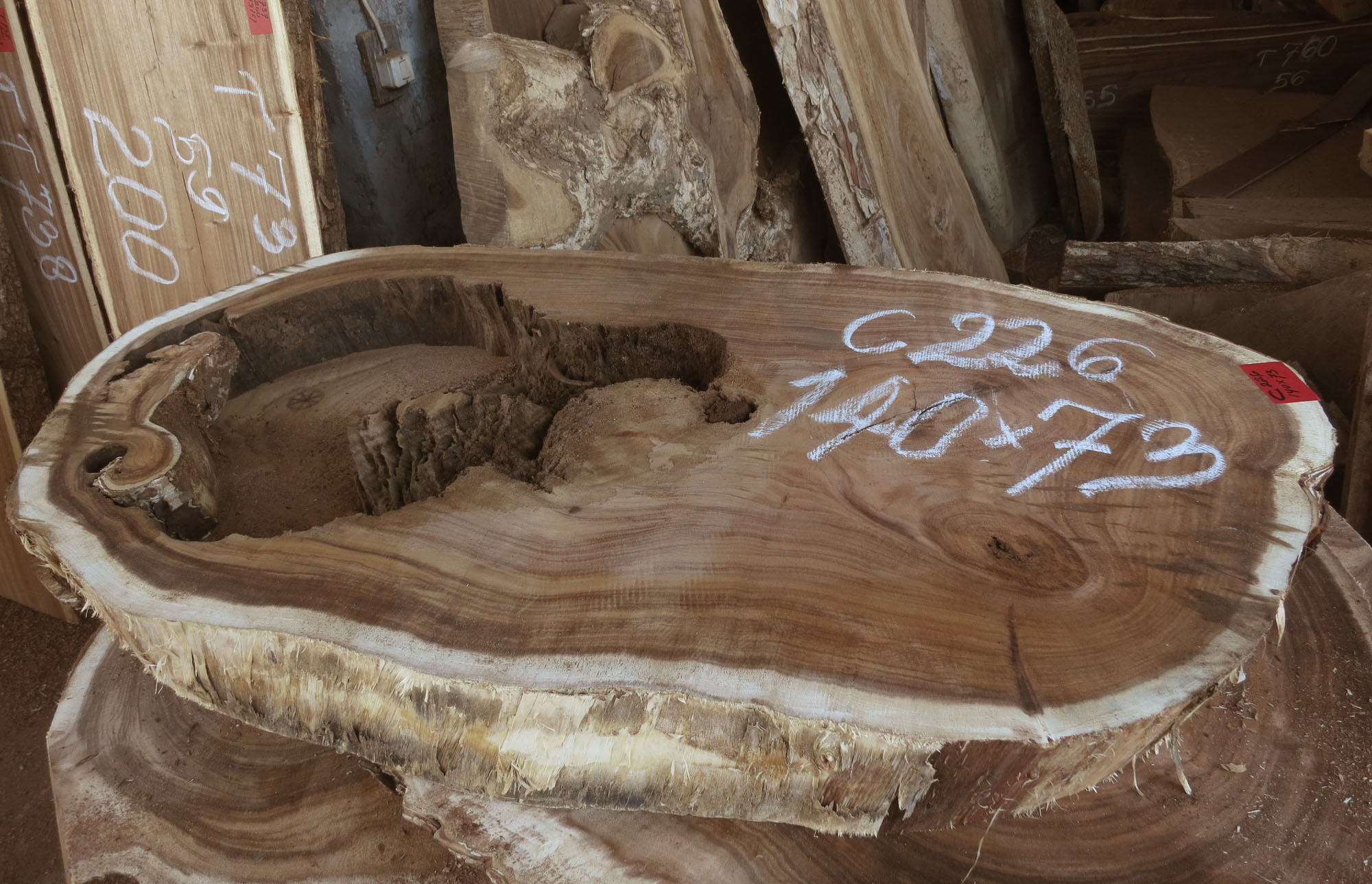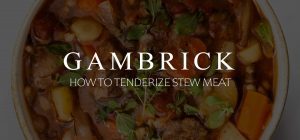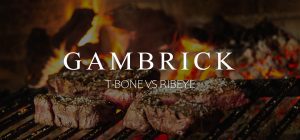What Is Wood Grain?
Wood grain is the orientation of cell fibers running through a piece of lumber. If you’ve ever used lumber or seen a cut tree trunk then you’ve seen wood grain. Each year a tree grows, it adds another line of grain to the wood which is called a growth ring. This greatly effects the texture and composition of the wood grain. There’s a texture you can feel to the touch and a beautiful appearance. Some cuts of wood have an intricate wood grain that’s great for finished cabinetry or a dining room table while other cuts are better for traditional lumber. Wood grain effects stain too. Some types get very dark while others have a lighter appearance. Each species of wood has it’s own unique grain so make sure you buy what’s right for your particular project. Grain has a lot to do with the strength of the wood too so that’s another consideration.
Wood is a fussy material that offers a wide range of features. It’s abundant, attractive, and easy to work with. And if maintained properly it can last for centuries. Some of the oldest buildings in the world were made with wood. However, wood is a complex and perplexing building material with a lot of variables.
When a tree grows, its wood cells align with the trunk, limbs, or root axis. These cells contain long and thin bundles of fibers. Generally these fibers are 100s of times longer than they are wide. As a tree grows each year it produces annual rings which leads to wood grain formation.
Choosing The Right Grain
A few years ago I worked on a custom bed set. I had to select the right slab of wood for the headboard and two bedside tables. When your choosing wood for a custom project like this it’s important to consider a few variables.Things like species, color, knots, work-ability and grain.
As you can see from the picture above, when you select a slab of wood the grain is super important. Especially when it’s for a finished project like a table or headboard. When making products like these it’s all about color and the grain. Texture isn’t as important because you’ll most likely be sanding and finishing but grain is super important. When the lumber is cut to size and finished, what you see is exactly what you’ll get as far as a finished look. Picture that lumber cut as a finished table top and how the wood grain will look as a finished surface.
Also consider how the grain will hold stain. The example above has a medium thickness. Meaning there are lots of lines mixed in with wide areas of wood in between. This sort of grain creates a marbled look which is something I really like.
Think of selecting the right wood grain in the same way you would a slab of stone for a countertop. What you see is your actual finished surface so make sure it’s exactly what you want before you buy and start working.
Grain Has Texture
If your working with wood it’s important to understand that grain has texture. It effects not only the look of the lumber but also how it feels. Texture refers to size, variation, type and arrangement of cells that you can feel and this affects the lumbers appearance. Fine-grain or coarse-grain are describing texture. The difference between fine-grain and coarse-grain wood is the way that cells are arranged and the size and arrangement of pores.
Texture refers to the relative size as well as the amount of variation in the size of the wood cells. These cells are arranged in bands called rays. There are also pores which vary in terms of size and distribution. All these variables help determine if the wood is considered a fine,medium or coarse textured wood.
Open grained and close grained wood refers to the size of the pores. Wood cuts with large visible pores are considered open-grain while cuts with small pores are considered closed.
Fillers are used quite a bit with larger open pore lumber to fill any gaps and create a smoother finish.
Woodworkers use the terms “fine-grained”,”medium-grained” and “coarse-grained” to describe the texture of the wood and rarely use the actual term “texture”. But that’s what they mean.
It’s very easy to see as well as feel the difference in grain.
Wood finishers will also refer to a hardwood as either open-grained or close-grained. This refers to the relative size of the pores and helps determine whether or not the surface requires a filler to get a smooth finish or if sanding is enough. Generally hard woods like oak have small tight pores and a good grain so only sanding is needed. However pine typically has bigger pores so some filler can be needed to get it really smooth.
Wood Grain Effects Strength
As a tree grows it adds an additional ring each year which you can both see and feel. The slower the tree grows the more rings it will have. These slower growing trees are much stronger than trees that grow fast. You can see the difference when you look at the grain. The tighter the grain the slower the tree grew and the stronger the wood is. If you want the strongest wood possible by slow growth lumber.
Another important thing to consider is to always secure your lumber against the grain. This adds a lot of strength. Grain is hard to bend when you go against it. But when you put pressure with the grain it’s much easier to bend. This can be a benefit in projects where you need to curve the wood. In these types of applications always install the wood with the grain. You can actually make a circle using this method.
Key Considerations
Fine lines or annual rings that represent growth cycles give essential characteristics to different types of wood. These are known as the wood grain. A tree adds growth rings each year, and when the wood is cut, these rings create the grain. Remember, carving or installing with the grain refers to cutting or installing in the same direction as the grain.
Experts say it is crucial to think of petting a cat or dog when understanding wood grain or its dynamics. For instance, when you stroke with the pet’s fur, it is nice and smooth because the hairs lay flat against the pet’s skin. On the other hand, if you stroke against the animal’s fur, it sticks up and resists your petting.
The same goes for the wood grain. If you carve against the grain, you will experience resistance. The reason is that your cutting tool will dig deep into the wood.
Some regions in the U.S, including Michigan and Minnesota, have short growing seasons, meaning the trees grow slower, leading to closer annual rings. On the other hand, trees grown in the southern region have a longer season, resulting in wider annual rings.
If you want to prevent the cutting tool from digging deep into the wood, it is crucial to cut with the wood grain. If the wood doesn’t show the grain, your knife or cutting tool will find it. Carve a tiny shaving off the woodblock to see the grain direction of the wood.
When you carve with the grain, the wood will shave easily. Conversely, if your knife digs deep into the wood, it means you are cutting against the wood grain. In that case, you have to turn the block around and try to carve it in the other
Types of Wood Grain
Grain and color patterns are the main elements that influence the wood appearance. Some characteristics, such as burls, stains, and insect damage, also cause the same effect. In this section, we will discuss some common types of the wood grain. Continue reading!
Open Grain
Some types of wood, including oak, pine, and butternut, have larger pores. These are known as coarse or open grain wood species. Unlike other wood materials, these types of wood have end grains that soak stains effectively and rapidly, leading to a blotchy appearance.
Besides, redwood, western red cedar, poplar, cypress, and aspen usually have straight grain. Similarly, beech and white oak also have straight grain, but you also find some species with figured grain. Walnut are open-grained wood species with grain ranging from straight to pattern.
Moreover, mahogany has a straight grain, but it also comes with unusual patterns, including mottle, stripe, and blister. Ash has a straight, wide grain with brown streaks. Bear in mind that open wood grain means larger grain, making it a unique piece of wood.
Closed Grain
As the name indicates, wood with close grain has clustered growth rings. Although wood with the closed grain can take stains well, they do it without blotching. Alder is a wood with straight grain, but you may find some variance in width.
On the other hand, rosewood, birch, and maple have straight but subtle grain. Hickory has a versatile grain that ranges from straight to pattern grain, unlike poplar and cherry with straight, fine grain. Pine is one of the most popular wood with straight grain, making it a unique choice for flooring and furniture.
Research shows that hardwoods come with closed or open grains. The wood pores determine the open and closed grains. Because open grain wood has larger pores, they are more visible to the naked eye. On the other hand, a closed-grain has smaller pores, leading to the formation of a smoother surface. That’s why closed-grain pieces of wood are best for interior decoration.
Figured Grain
Experts recommend choosing and using figured wood to enhance the wood quality and streamline your project. Remember, figured grains are not specific to one tree type. For instance, bird’s eye wood has dimples or spots, structures that are similar to eyes. Using this type of wood can add a unique touch to your wood project.
Besides, some woods, such as fiddle-back wood, has a large number of ripples arranged in series, making it a unique material. Fiddle-back wood is commonly used for constructing violins’ backs. Fungi are microbes that form spalted wood with black streaks running through different patterns.
You can also find wood with silver, quilt, burl, crotch, ribbon, and curly figures. A tree with a larger branch that meets another tree’s trunk often leads to crotch wood, producing noticeable swirls and twirls in the wood.
Exotic Grain
Some woods with exotic characteristics have unusual grain patterns. For instance, zebrawood is an exotic wood with broad dark lines. However, you can also find it in swirling dark lines.
Australian-based wood, known as Lacewood, have grain that resembles hammered copper. South-American-based wood called Tiger-Wood has a dark orange appearance with striped grain that gives a unique look, resembling tiger stripes.
Moreover, cocobolo wood has a deep orange appearance with black stripping grain. Teak is another exotic wood with straight grain, making it an excellent choice for outdoor furniture due to its incredible resistance properties that can withstand harsh weather conditions.
How Wood Grain Is Created
Trees are a living thing with a complex structure that changes are it grows. You can tell a lot about the life a tree by examining it’s grain. Below is a list of all the internal parts of a tree and it’s grain.
Wood grain is created when longitudinal cells align with the trunk, root, or limb axis. The process occurs when a tree cambium grows, generating two types of wood cells. Remember, most of these cells have a longer, narrower, and longitudinal structure. When these cells align with the tree trunk axis, they form wood grain.
- At the very center of a tree trunk is what’s called the the pith. In some trees, this area is much softer and sometimes a different color than the surrounding areas which are called the heartwood.
- Heartwood is made up mostly of dead cells that help support the tree.
- Next is the sapwood, This layer carries water, minerals, and sugars between the roots and the leaves. This is generally lighter in color than the heartwood.
- Next is the cambium. It sits just outside the sapwood, close to the surface and just under the bark. The cambium is made up of a thin layer of living cells that manufacture new wood as the tree grows. Cambium generally grows the fastest in spring, creating light colored springwood. As temperatures warm, it slows down and produces darker summerwood. This later growth is typically denser than springwood. When the weather gets cold, the cambium becomes dormant until spring. This cycle produces growth rings.
Wood Grain Direction
As the cambium grows, it creates two types of cells. Most are long, narrow cells that run along the axis. These are circular in direction and give wood its grain.
The cambium also produces a smaller number of ray cells that extend out from the pith. They do not run in a circle but are more perpendicular to the axis. The ray cells cut across the circular cells extending from the center of the tree to the bark.
As the tree grows, protoplasm inside the cells die, leaving behind the cell walls. These walls are mainly cellulose fibers, which gives wood its strength. When you cut a tree down and look at it’s trunk, most of what you see are these cell walls. It’s typically just the outer edge of the tree just under the bark that’s still alive and growing.
Fibers are held together with lignin, a glue like substance. Hollow cells running throughout the tree carry sap up and down the trunk and throughout it’s branches as well as storing plant sugars.
Over time, older sapwood eventually turns to heartwood. As sap dries up, mineral compounds called extractive forms on the cell walls. These compounds change the wood’s color, generally making it darker and giving it the characteristic color of its species. Some species become a deeper brown, some greenish, yellow, gold, red, etc.
Extractive compounds also affect a trees strength, durability, and hardness.
Understanding
Wood grain is very important because it’s not only functional but also very attractive. And it greatly effects how you work with the wood. Because of the way a tree grows, every piece of timber has a different grain design and direction. No two pieces will ever be exactly the same so furniture and cabinet makers will hand select each piece looking for not only attractive cuts but also good work ability.
The better the cut the more expensive it will typically be.
The basic descriptions and types include:
- Straight: runs in a single direction along cut lumber. Easy to work with.
- Cross: created when some cells grow out from the center of the tree. Harder to work with.
- Spiral: develops as the trunk of the tree twists during development. Even harder.
- Interlocked: occurs when a twisting trunk develops misaligned grain. The hardest.
Each type can have beautiful patterns. Choose what’s right for the type of product your working on. Most cabinet doors use straight grain but large tables look great with more intricate patterns.
Summary: What Is Wood Grain?
Wood grain is the orientation of cell fibers running through a piece of lumber. If you’ve ever used a piece of lumber or seen a cut tree trunk then you’ve seen wood grain. Each year a tree grows it adds another line of grain called a growth ring. This greatly effects the texture and composition of the wood. There’s a texture you can feel to the touch and a varying appearance. Some cuts have a beautiful grain that’s great for finished cabinetry or a dining room table while others aren’t as nice. This effects stain too. Some types get very dark while others have a lighter appearance. Each species of wood has it’s own unique grain so make sure you buy what’s right for your particular project.
Grain has a lot to do with the strength of the wood too so that’s another consideration.
Wood is a fussy material that offers a wide range of features. It is abundant, attractive, and easy to work with. And if maintained properly it can last for centuries. Some of the oldest buildings in the world were made with wood. However, wood is a complex and perplexing building material with a lot of variables.
When a tree grows, its wood cells align with the trunk, limbs, or root axis. These cells contain long and thin bundles of fibers. Generally these fibers are 100s of times longer than they are wide. As a tree grows each year it produces annual rings which leads to wood grain formation.
If you have any questions or comments about wood grain E-mail any time.






















